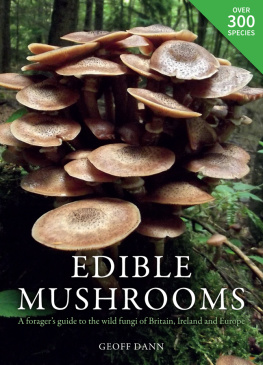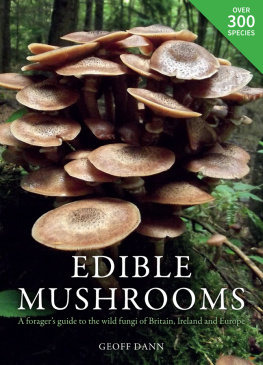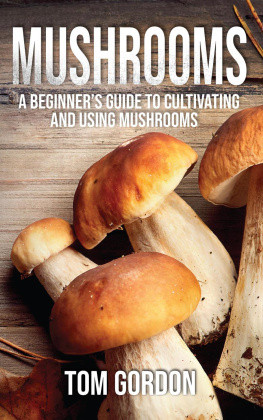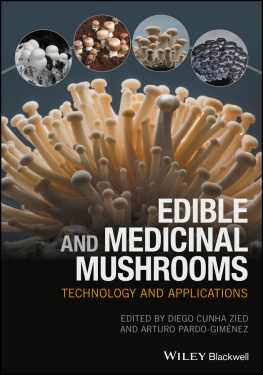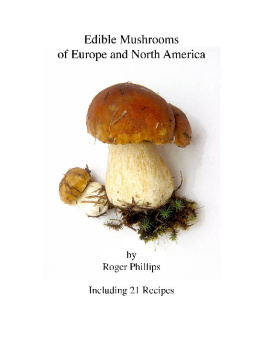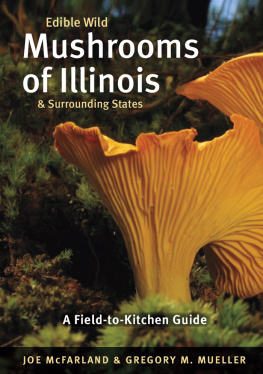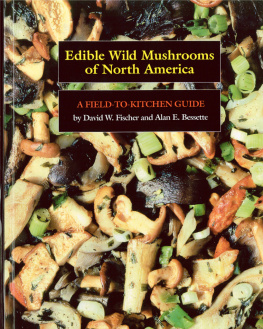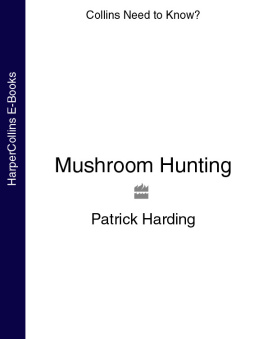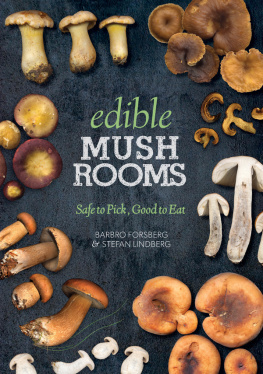Geoff Dann - Edible Mushrooms
Here you can read online Geoff Dann - Edible Mushrooms full text of the book (entire story) in english for free. Download pdf and epub, get meaning, cover and reviews about this ebook. year: 2016, publisher: UIT Cambridge Ltd, genre: Children. Description of the work, (preface) as well as reviews are available. Best literature library LitArk.com created for fans of good reading and offers a wide selection of genres:
Romance novel
Science fiction
Adventure
Detective
Science
History
Home and family
Prose
Art
Politics
Computer
Non-fiction
Religion
Business
Children
Humor
Choose a favorite category and find really read worthwhile books. Enjoy immersion in the world of imagination, feel the emotions of the characters or learn something new for yourself, make an fascinating discovery.
- Book:Edible Mushrooms
- Author:
- Publisher:UIT Cambridge Ltd
- Genre:
- Year:2016
- Rating:4 / 5
- Favourites:Add to favourites
- Your mark:
- 80
- 1
- 2
- 3
- 4
- 5
Edible Mushrooms: summary, description and annotation
We offer to read an annotation, description, summary or preface (depends on what the author of the book "Edible Mushrooms" wrote himself). If you haven't found the necessary information about the book — write in the comments, we will try to find it.
Edible Mushrooms — read online for free the complete book (whole text) full work
Below is the text of the book, divided by pages. System saving the place of the last page read, allows you to conveniently read the book "Edible Mushrooms" online for free, without having to search again every time where you left off. Put a bookmark, and you can go to the page where you finished reading at any time.
Font size:
Interval:
Bookmark:
Edible Mushrooms

Horn of Plenty.
Edible Mushrooms
A foragers guide to the wild fungi
of Britain, Ireland and Europe
Geoff Dann


I was fortunate to have grown up roaming the woods and old grassland on the ridge of the North Downs in Surrey, south-east England, and my interest in the wild things around me goes back to about the time I learned to walk. My love of fungi in particular started with a search for the hallucinogenic variety in my late teens (in the mid-1980s). It became apparent that while my intended quarry was not so easy to find, a dazzling variety of other fungi were available, some of which had to be edible. And so I began using the first edition of Mushrooms by Roger Phillips to learn how to identify what I was finding. There was no internet to help me, nobody to teach me and no other books even half as good. It took plenty of time, and plenty of caution. Fungi foraging remained my hobby and passion for the next 20 years, while my day job was software engineering, a career I left in 2005 to study philosophy and cognitive science at Sussex University.
In 2008, with my studies over and time on my hands, I set myself a personal challenge of scouring the extensive woodlands of Sussex for every edible and toxic species of fungi that I should have found/identified, but hadnt. This wasnt intended as a career move any more than the philosophy degree, but my knowledge and passion for the subject was noticed by the owner of a recently created fungi foraging website, and he offered to promote my services as a foraging guide in return for writing articles for his website. Lacking any other job, it seemed silly to say no.
One thing then led to another and, without any real effort on my part to develop my new career in any particular direction, each autumn I found myself working full-time teaching people about edible and poisonous fungi. In 2011 I started collecting photos with a vague plan to one day write a book about fungi foraging. Five years later, it has become a reality.
My first debt of gratitude is to the numerous people who have helped me via the Fungus Conservation Trust (formerly the Association of British Fungus Groups), especially Michael Jordan, without whom the FCT would not exist. Others who have kindly taken the time to identify fungi I couldnt are Roy Betts, Leif Goodwin, Roy Miller, Andreas Gminder, Chris Johnson, Mal Greaves and Pavel Nedelev.
Of course I am also indebted to the combined work of generations of mycologists, but especially to Roger Phillips, whose 1981 book Mushrooms made it possible for me to start learning about fungi foraging in my teens. Thanks also to Nigel Frith and Kerry Reynolds for encouraging me to start teaching people about edible wild fungi.
Id like to thank Kerry, and also Neil Woolley, for providing feedback on early drafts, Mavis Addis for the Ganoderma artwork and Liz Holden for assistance with new English common names, and Melissa Waddingham for taking me truffle hunting.
For the use of their photos Id like to thank Ian Bastone, Justin Long, Herbert Baker, Dr Holger Krisp, Gerhard Koller, Sava Krstic, Andreas Kunze, Jerzy Opiola, Ron Pastorino, Ryane Snow and Walt Sturgeon.
I am grateful to the following for their invaluable contributions:
Distribution data: Data courtesy of the NBN Gateway with thanks to all the data contributors. (The NBN and its data contributors bear no responsibility for the further analysis or interpretation of this material, data and/or information.) Data also courtesy of the Global Biodiversity Information Facility and all its data contributors.
Species descriptions: With thanks to Roger Phillips, Stefan Buczacki, Michael Jordan, Paul Sterry and Barry Hughes, whose works were used as reference guides when composing and checking the species descriptions.
Cooking tips: With thanks to Elisabeth Luard, Roger Phillips, Amy Farges, Joy Spoczynksa, John Wright and Richard Mabey for inspiration regarding wild mushroom cookery.
Finally I thank my wife, Cathy, for her support in so many ways during the process of creating this book.

Foraging for fungi is an addictive pastime that can border on an obsession. It is fun, free and endlessly fascinating. You experience the thrill of the hunt, the satisfaction of adding to your collection each time you try eating something new, and the reward of learning about the natural world. You have the perfect excuse to go out and explore the countryside, not just by the well-beaten path but off-piste to quiet places where most people have no reason to go and nature still rules. And with a bit of luck you get to take home a selection of delicious, free, unusual and healthy food. Its a taste of what our ancestors did right up until the invention of agriculture a chance to use brain and body to do one of the things evolution actually designed them to do. You never know what lies around the next corner: it could be the mother lode of a famous delicacy, it could be something youve been seeking for years but never found, or it could be a strange and wonderful species you never even knew existed.
Whether youre a Brit who knows nothing at all about edible wild mushrooms or a Continental European whose family have been collecting them for generations, this book is for you. It is a comprehensive, state-of-the-art guide to every species of interest to a forager in the temperate and mountainous zones of Europe. All species are illustrated with clear in-situ photos, and for each edible species I describe how good it is to eat, where and when to find it, how safe or dangerous it is to collect, and how to distinguish it from similar species. The important poisonous fungi are also covered as well as a few that are of interest because they are exceptionally common, or because they are useful as something other than food medicines, dyes, tinder, etc.
When I started teaching myself to forage for wild fungi in the 1980s, almost nobody in the UK knew anything about this subject. There was no grandmother to teach me, no classes to attend, and no internet to consult. The only guide worth using was a reference book (first published in 1981) that features hundreds of species of fungi of no interest to a forager, and minimal information about edibility. Thirty years and a great deal of caution later, Ive completed a self-taught journey from absolute beginner to professional teacher. This book contains all the information I wish Id had at the start it would have made that journey a great deal easier.
Depending on how you count them, about 300-400 European species of wild fungi are considered edible (although some arent that tasty). This book gives detailed information on about 250 of these, including all the best ones, as well as more than 50 poisonous species. How you count them really does matter, as a surprising number of mushrooms that are considered edible in one region are dismissed as poisonous in another; and a few that have been prized historically are now known to be seriously hazardous (and in some cases they have only fallen from grace very recently). Some good edible species have been dismissed because they resemble something dangerously poisonous. There is also one species, only discovered in 2004 but already common in north-west Europe and spreading fast, that can provisionally be added to the edible list although at the time of writing, very few people have actually tried eating it.
Next pageFont size:
Interval:
Bookmark:
Similar books «Edible Mushrooms»
Look at similar books to Edible Mushrooms. We have selected literature similar in name and meaning in the hope of providing readers with more options to find new, interesting, not yet read works.
Discussion, reviews of the book Edible Mushrooms and just readers' own opinions. Leave your comments, write what you think about the work, its meaning or the main characters. Specify what exactly you liked and what you didn't like, and why you think so.

